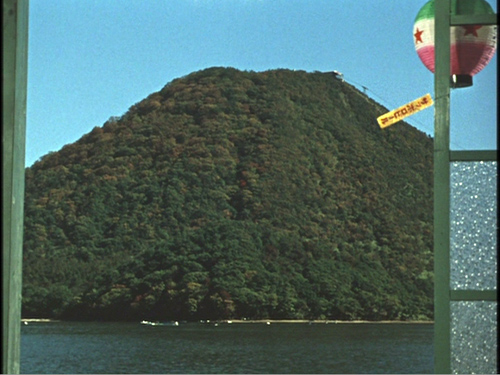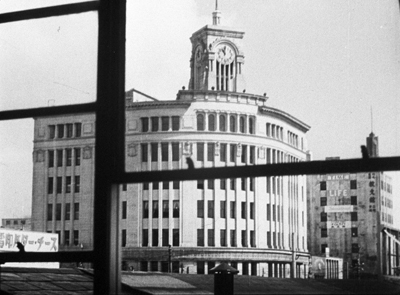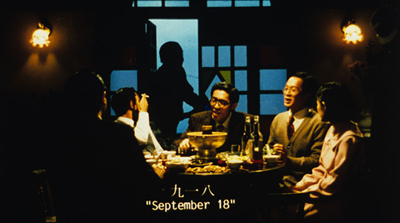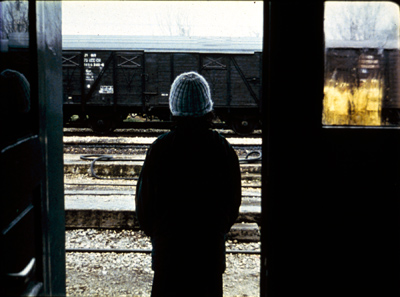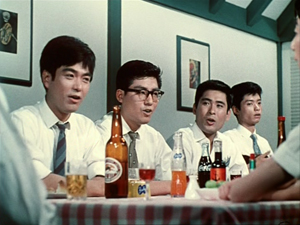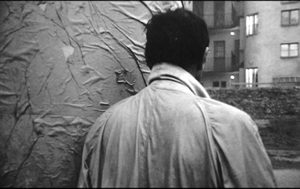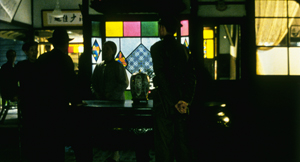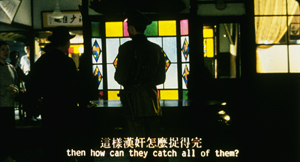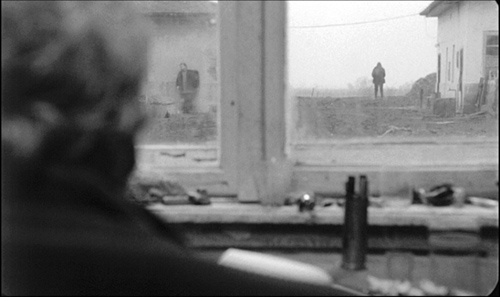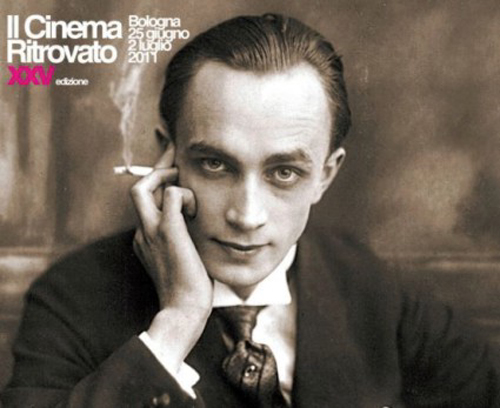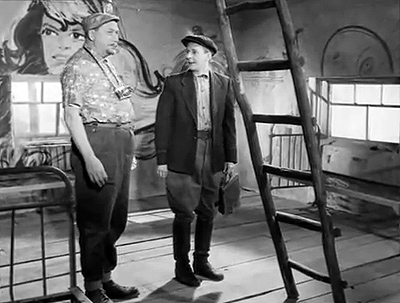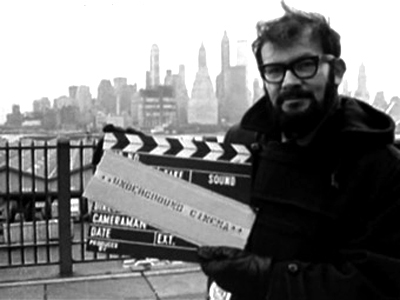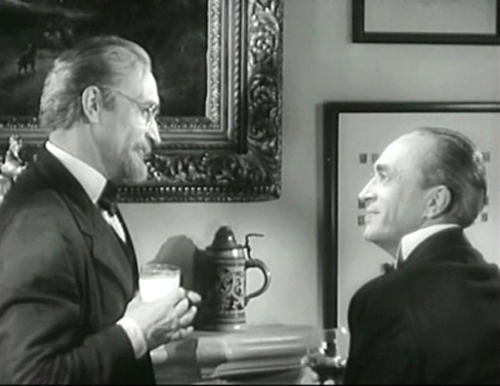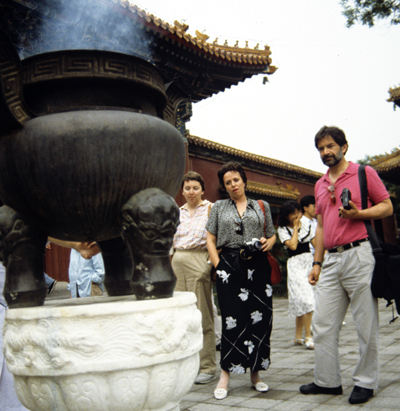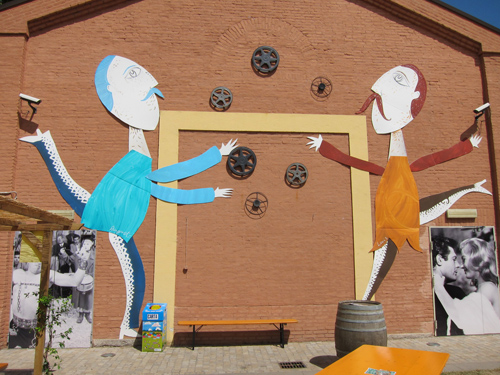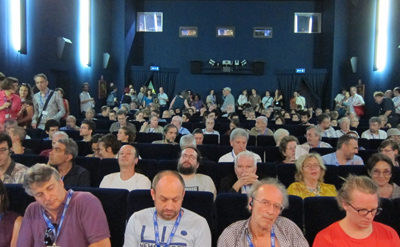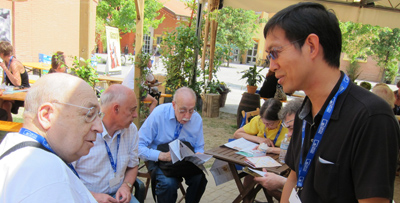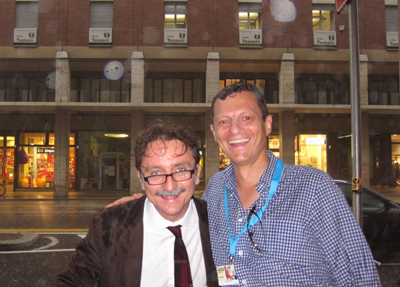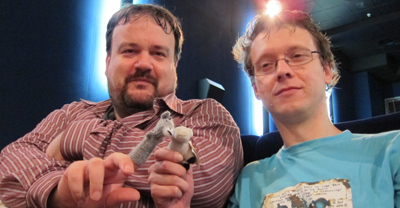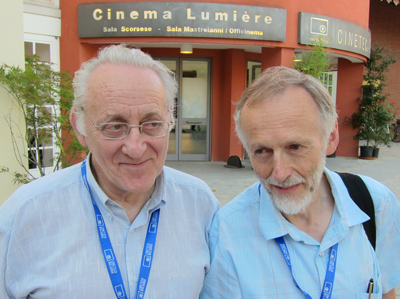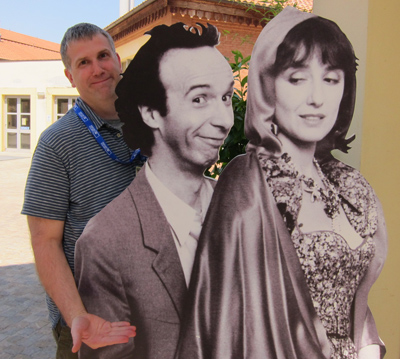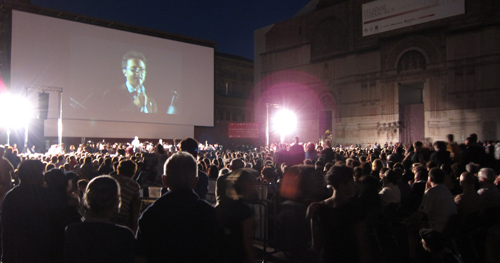Archive for July 2011
Good and good for you
Late Autumn (Ozu Yasujiro, 1960).
DB here:
Manohla Dargis of the New York Times has just written a piece that refers to some ideas that have appeared on this site. If you see the article online, you’ll find the links to appropriate entries, but if you’ve come here after reading the paper edition of the Times, you can find the Tim Smith essay she cites here. It is a remarkable piece of work, and it’s gratifying that Dargis has called attention to it. (Tim’s video experiments have received many hundreds of thousands of downloads already.) My table-setting entry, on task-driven looking, is here.
The backstory is simple. On this site in 2008, I took a slow, unemphatic scene from There Will Be Blood as an example of how a director can subtly guide our attention without cutting, camera movement, or auditory underlining. My analysis was guided by recognition of my own responses and some knowledge of traditions of cinematic staging. Tim, in his turn, used the tools of modern perceptual research to show that we can gain firmer knowledge of directorial craft. By tracking viewers’ eye-scanning, Tim demonstrates vividly that filmmakers can shape our experience of the action on a second-by-second basis. This not only helps us understand how we grasp images. It shows that humanistic inquiry and psychological research can collaborate.
Why so unserious?
Late Spring (Ozu Yasujiro, 1949).
Those who navigate Internet eddies and flows know that dozens of responses have swirled around Dan Kois’ “Eating Your Cultural Vegetables.” Kois wants to like long, slow movies, but after trying for years, he has found that he just can’t enjoy many of them. He can mimic, even anticipate, the judgments of those who do, but in his heart he finds most of the celebrated films boring. He’s now decided to give in to his impulse and declare that he needn’t pretend to enjoy Tarkovsky or Hou Hsiao-hsien:
As I get older, I find I’m suffering from a kind of culture fatigue and have less interest in eating my cultural vegetables, no matter how good they may be for me.
As one man’s confession of guilt and fatigue, this is doubtless sincere, although its sideswiping putdowns of viewers who praise such movies suggest more calculation than humility. Still, this cry from the heart has broader implications, as many Net writers have discussed. Kois’ complaint elicited not one but two responses from the New York Times film critics A. O. Scott and Manohla Dargis. For one thing, Kois’ essay seems to offer aid and comfort to people who are afraid to try something different. Indeed, it lets them feel superior to the phonies who claim to like such films. Moreover, Kois justifies the most superficial response a moviegoer can make. Simply shrugging off a film by saying, “It’s boring!” is about as uninformative a response as saying, “It’s interesting!” And one should always be suspicious of somebody, in the name of debunkery, telling us that we shouldn’t bother to know something.
Kois’ piece exploits the special status that film enjoys in today’s culture. High and low mingle. Because movies are so accessible, and Hollywood movies are so eager to give us what somebody has decided that we want, coterie tastes are dismissed as snobbism. Things seem different in other arts. Would the Times publish a piece in which someone confessed to finding Tarkovsky’s contemporary, the Soviet composer Sofia Gubaidulina, boring? No, because to talk about her is already to enter a restricted and high-level conversation. It goes without saying that a great many listeners would be bored by her music, but who cares what non-experts think about a modern composer? Film, however, is a free-fire zone; anybody’s opinion is worth a public hearing.
I’ve kept out of the fracas because I thought Kois’ piece was silly-season fluff. Of course I wrote my own replies in my head, such as We used to have a name for this: Philistinism. I also thought that the essay operated in bad faith. Kois wasn’t as apologetic as he tried to seem. He claims humility (he “yearns…to experience culture at a more elevated level”) when really disdaining this area of cinema and considering the people who claim to enjoy it mere poseurs. The exaggerations show, I think, that this is not a serious piece:
Surely there are die-hard Hou Hsiao-hsien fans out there who grit their teeth every time a new Pixar movie comes out.
Surely not.
Still, Kois’ complaint touches on something important about film history. We have a polarized film culture: fast, aggressive cinema for the mass market and slow, more austere cinema for festivals and arthouses. That’s not to say that every foreign film is the seven-and-a-half hour Sátántangó, only that demanding works like Tarr’s find their homes in museums, cinematheques, and other specialized venues. Interestingly for Kois’ case, many of the most valuable movies in this vein don’t get any commercial distribution. The major works of Hou, Tarr, and others didn’t play the US theatre market. Sátántangó is just coming out on DVD here, nearly twenty years after its original appearance. Most of us can’t get access to the most vitamin-rich cultural vegetables, and they’re in no danger of overrunning our diet.
The race is to the slowest
City of Sadness (Hou Hsiao-hsien, 1989).
For the historian, the polarization between fast pop movies and slow festival films asks to be explained. My take goes roughly this way.
From the 1940s through the 1960s, certain directors developed a new approach to telling stories. Antonioni, Dreyer, Bergman, and a few others opted for a style that relied on slower pacing and even “dead moments” that seemed to halt the narrative altogether. “Dedramatization,” it was sometimes called, and many rightly considered it a powerful innovation in the history of film as an art. But these films did get a purchase on the international movie market, often for other reasons (sex in Antonioni and Bergman, religiosity in Dreyer). They also came along at a time when there was a niche audience eager to have new cinematic experiences. (On this period see Tino Balio’s Foreign Film Renaissance on American Screens.)
But artists being artists, competition grew up. The long take, for instance, got longer and more virtuosic. Miklós Jancsó, shamefully ignored today, made a series of pageants of Hungarian history in superbly sustained, intricate camera movements; some of his films have only twelve shots. But his films are sumptuous compared to what we found elsewhere. From the late 1960s through the 1970s, it seems, a new generation of filmmakers competed to make ever more austere films. They often kept the camera fixed, framed the action at a distance, and sustained the shot for many minutes. The works of Jean-Marie Straub and Danièle Huillet are the high-water marks of this trend, but there were also Chantal Akerman, Theo Angelopoulos, and even Rainer Werner Fassbinder (Katzelmacher) and Wim Wenders (Kings of the Road). Werner Herzog’s successful career as a documentarist has perhaps let people forget that he once made very slow and demanding films like Fata Morgana; his Heart of Glass, screened in US arthouses in the 1970s, would surely not find a distributor today.
From a marketing standpoint, the avant-garde overplayed its hand. The new austerity came along just when Spielberg and Lucas were reinventing Hollywood. As movies got faster and louder, long-take minimalism looked perversely ascetic. Some of the directors, like Straub and Huillet, remained loyal to their project; others crossed over. It is quite a shift from Akerman’s Jeanne Dielman, 23 quai du Commerce, 1080 Bruxelles (1975), a 201-minute film mostly about housework, to the musical The Golden Eighties (1986) and A Couch in New York (1996). Likewise with Wenders’ Summer in the City (1970) and Wings of Desire (1987). I happen to admire both strains in these directors’ works, but there’s no doubt which is the more audience-friendly.
Today, directors who persist in long-take, slowly-paced storytelling are aiming chiefly at the festival market, which means that most of their films will be shown theatrically only, to be blunt, in France. But some of the greatest directors of our time, notably Hou Hsiao-hsien, Edward Yang, and Abbas Kiarostami, have done their best work in this mode. The US arthouse market has taken decades to discover them, through more accessible works like Flight of the Red Balloon, Yi Yi, and Certified Copy. Kois confesses to loving Yi Yi, so I’d urge him to look at Yang’s Terrorizers and A Brighter Summer Day, more rigorous but no less gripping films, though they lack the traditional arthouse bait of a charming child. Hou’s Red Balloon also has a cute kid and refers back to an arthouse classic, while Kiarostami, not normally given to couples and romances, offers us in Certified Copy a pleasantly teasing take on Antonioni and Resnais.
Minimalism of the 1970s variety got revived by 1980s American indies, notably Jim Jarmusch, but with more entertainment value. In later years he too crossed over stylistically; however unpredictable the plot maneuvers of Ghost Dog and Broken Flowers, they lack the long takes and open-ended unfolding of time we find in Stranger than Paradise. Even Kelly Reichardt, one of Kois’ targets, doesn’t give us anything like the severity of the 1970s generation. That makes the “purer” films from overseas that persist in this tradition even more off-putting. If Kois can’t take Meek’s Cutoff, as he claims, he’d find Hong Sangsoo (Oki’s Movie) or Liu Jiayin (Oxhide and Oxhide II) cinematic chloroform.
So Kois may assume that “boring” films have persisted in today’s film culture because of snobbism, but there are deeper reasons. The competition among filmmakers to push an aesthetic horizon further, the narrowing of audience tastes, the search for a budget-appropriate niche that could stand in opposition to the visual spectacle of the New Hollywood–these seem to me important factors in making slow movies a ghetto for cinephiles.
Why shouldn’t people follow Kois in giving up their vegetables? No reason, except that they’re missing some worthwhile cinematic experiences. Not all austere movies are good, but viewers who want to expand their cinematic horizons should consider the possibility of learning to look at certain movies differently. Kois can’t see that; he thinks that people who like the movies that bore him are usually phonies. But I believe that some of those admirers have developed a repertory of viewing habits that adjust to different cinematic traditions. If you can like both Stravinsky and rock and roll, why can’t you like Hou and Spielberg?
Look again, closer
Voyage to Cythera (Theo Angelopoulos, 1984).
This is the prospect opened up by Dargis’ latest article. She suggests that Kois’ response isn’t wholly based on taste. It may stem from literally not knowing how to look at certain kinds of movies.
Kois’ article treats most defenses of slow films as a matter of hand-waving and you-see-it-or-you-don’t attitudinizing. Again, he has a point: Those reactions are common, I think. The fact that cinephiles must face is that this sort of film is very difficult to talk about. We can point out the creative choices in Hollywood because narrative in some degree drives everything we see and hear. But when narrative relaxes, most viewers don’t know what to look or listen for.
The problem has haunted me for decades, ever since the 1970s when I took an interest in Ozu, Bresson, Dreyer, and Mizoguchi–all filmmakers felt, at the time, to be slow. I failed to come to grips with the problem in my 1981 book on Dreyer; I even anticipated Kois in calling Gertrud (another item that would never grace theatre screens today) boring–but I took that to be a good thing, as a challenge to conventional viewing habits.
What can I say? I was young. Since then, I think I’ve come up with better ways of talking about the other directors I mentioned, as well as some in their camp, such as Angelopoulos and Hou and Tarr. A lot of my answer comes down to the way, pace Dargis and Smith, they structure our attention.
My arguments are set out in the places I mention in the tailpiece of this entry. In brief, these filmmakers become engaging, even entertaining, when we realize that they are to some extent shifting our involvement from characters and situations to the manner of presentation. Not narrative but narration is what engages us. And we need, as Dargis points out, some schemas for grasping these alternative patterns. We have robust and refined schemas for following a story, but grasping the dynamics of narration, the how as well as the what, takes more practice, and perhaps some instruction from critics.
The process is like taking in an opera on two levels: following the stage action but also registering the patterns, the emotional highs and lows, of the music that accompanies–and sometimes overwhelms–it. Let Papagena and Papageno stammer each one’s name again and again. The repetition isn’t needed for the drama, but it’s thrilling on sheerly musical grounds.
Now imagine that sort of development transposed to cinema, in which we can appreciate, at one and the same time, not only the story’s unfolding but the patterns that present it. The supreme master of this possibility, I think, is Ozu, perhaps cinema’s Mozart. But you can find the same qualities in more somber key elsewhere. For example, in watching Angelpoulos’ Voyage to Cythera, I think that you have to be prepared to see the arrival of track workers in yellow slickers, visible through the speckled window pane in the shot above, as a kind of visual epiphany, the quiet equivalent of a stunt in a summer tentpole picture.
Given a narrative mandate, we’re on the lookout for pictorial factors that affect the dramatic situation. But when narrative slows, other things, maybe not of narrative moment, pop out, like the yellow-garbed train workers on their handcar. At such moments, it’s not that our eyes roam around aimlessly; it’s that the director guides us in a different way, toward a visual search that isn’t wholly driven by plot considerations. Here’s a shot from Ozu’s End of Summer (1961).
The principal action is a party of young people singing. But the faces are no more important than the gleaming drinks on the table, a little suite of colors and shapes that become fascinating in themselves. (For instance, several of the liquids and bottle labels sit along the same horizon line, regardless of how far the drinks are from us.) You don’t discover this half-gag, half-still-life by groping: Ozu has lit it and composed it so that you’re invited to discover it. He has found a way to activate what in most movies would be filler material. And if you think that noticing colors and shapes on the tabletop is just trivial, consider that we enjoy staring at the same sorts of patterns in an abstract Kandinsky. Or is he cultural roughage too?
In an Ozu film, even though he cuts rather fast, we’re given time to see everything. But this isn’t random rummaging. It’s visual exploration guided by Ozu’s decisions about composition, lighting, and color. Something similar, I think, is going on with Tarr, although there it’s more a matter of texture and tactile qualities. His people shamble through mud, oily puddles, dusty corners, and tearing winds. In one shot of Damnation, a rain-soaked wall shrivels to match a wrinkled topcoat.
The story is still going forward, but by turning his protagonist from us and aligning him with the wall, Tarr has given his shot an extra layer of sensuous appeal. Try to remember the way any wall looked in Transformers 3, before it got blasted to rubble.
Slow movies let us look around, and good slow-movie makers give us something to see when we do. But what do we do when these accessory appeals don’t just accompany the narrative but swamp it? What if we lose track of the characters? The film may steer us to pictorial or auditory qualities that take over our perception.
The authorities are looking for a man in the family in Hou’s City of Sadness, but you have to rely almost solely on dialogue to identify what’s going on and who’s speaking.
The sheer pictorial beauty of the shot becomes a sort of anti-narrative pretext. But if you’re alert, you won’t take the plot off the table, because at one crucial moment a figure flashes through the far left background, more or less fully lit, who may be the suspect the cops are seeking.
Sometimes you have to destroy narrative in order to save it.
Hou asks that we engage with his distant, fixed images in a complex way, being patient but vigilant, enjoying abstract geometry while also sustaining old-fashioned suspense. It’s this dynamic between story and style, fastening on plot elements but also discovering accessory pleasures and patterns, that I think constitutes one delight of the sort of films that Kois finds boring.
Add Bresson, Mizoguchi, Dreyer, Tarkovsky, and others to my list of directors whose very different styles invite us to explore what the rapid pace of most narrative cinema refuses to dwell upon. These filmmakers invite us to grasp the space and time of a scene in a fresh way. The details and dimensions of a world surge forward, not simply as a backdrop for characters hurtling toward a goal, but as something valuable in their own right. For some viewers, me included, they do more. They also ask you to transfer those viewing skills to life outside the theatre. They encourage you to find a new way to look at our world.
Not all slow, minimalist movies are good. That’s why I think critics are obliged to rebut Kois with careful analysis, not the gaseous generalities about sublimity and eternal mystery to which we too often resort. Digging deeper, we can not only answer skeptics but expand our understanding of how cinema works. These films have opened windows for many of us. Why should we keep them to ourselves?
First, thanks to Manohla Dargis for enjoyable correspondence about these issues.
Tim Smith’s blog, Continuity Boy, is a good way to keep up with his energetic and expanding research program.
Dargis mentions the invisible gorilla experiments of Chabris and Simons. I talk about their relevance to film here and here.
Kristin has written on comparable matters in Tati; she even wrote an essay on M. Hulot’s Holiday called “Boredom on the Beach.” (It and an essay on Play Time are in her book Breaking the Glass Armor.) Tati’s films, in their spasmodic pauses and shamelessly repeated or sustained gags, could also count as part of the postwar dedramatization trend.
My initial arguments about different registers of viewer perception and cognition were made in Narration in the Fiction Film (1985). My case for Ozu is in Ozu and the Poetics of Cinema, available online. More recently, I’ve become interested in cinematic staging and have concentrated on challenging directors like Mizoguchi, Angelopoulos, and Hou; see On the History of Film Style (1998) and Figures Traced in Light (2005). All of these “slow” filmmakers ask us to be sensitive to unusual sorts of narrative patterning, and some purely non-narrative patterning. More thoughts on these matters can be found in The Way Hollywood Tells It (20006) and Poetics of Cinema (20007).
On this site, you can find similar lines of argument, especially about Béla Tarr, Mizoguchi Kenji, and silent directors like Louis Feuillade, Victor Sjöström and some Danish creators. See director entries for Hong Sangsoo, Liu Jiayin, and others mentioned above. Later this month I hope to post a bit more about how directors guide our attention without recourse to fast-paced editing–before editing was really invented.
Sátántangó (Béla Tarr, 1994).
More riches from Bologna
We’re still catching up with last week’s generous Cinema Ritrovato in Bologna, the world’s premiere festival of restored and rediscovered films from all eras.
DB here:
O Segredo do corcunda (The Hunchback’s Secret, 1924) was more than a curiosity. Directed by the Italian Alberto Traversa, it was the first Brazilian feature screened abroad. It also has a documentary bent in that it shows a bit of what coffee farming was like in that era. The plot traces how the budding romance between a poor boy and the plantation owner’s daughter is blocked by the overseer Pedro, who actually killed the boy’s father.
The film illustrates penetration of Hollywood filming technique around the world. The linear plot includes a flashback explaining key motivation, a romantic subplot with helper characters, and a last-minute rescue built out of parallel editing. Scenes are filmed and cut according to continuity principles, with eyeline matches and angled changes of setup. There is even a split-screen delirium sequence.
Yet the film was out of step with Hollywood in one respect: the proportion of titles, especially dialogue titles. O Segredo do Corcunda has a lot of intertitles; they make up 22% of all its 518 or so shots. Somewhat similar proportions can be found in the mid-1920s in Hollywood, as Upstream and Cradle Snatchers indicate. But what’s different is the proportion of dialogue titles to expository ones. Most Hollywood films of the period have a very small proportion of expository titles, usually no more than 15% of all titles, and often much less. Fazil, discussed in an earlier entry, has 118 dialogue titles and only seven expository ones. But in O Segredo the 65 dialogue titles comprise 57% of all titles, leaving the 49 dialogue titles to make up the difference.
Why does this matter? In The Classical Hollywood Cinema, I argued that American generally tend to favor methods that let the story seem to tell itself. Although an early silent feature might have many expository titles, in the late 1910s and the early 1920s, films began minimizing expository titles and letting dialogue carry the action. By the 1920s a US film would have relatively few expository titles. The pattern is visible across a film as well, with expository titles most common in the opening scenes but diminishing as the plot proceeds. In Segredo, not only do expository titles do more work, they’re spread out pretty evenly across the film. An external narrational authority is there from start to finish.
I suspect that the method of fading external authority is an identifying mark of American silent film and is rarer in other cinematic traditions. If that hunch is right, we can ask: Why did other countries persist in using expository titles so much? Matters for further research!
Polustanok (A Small Station).
Boris Barnet started out as one of Lev Kuleshov’s circle, and he became a well-established director. Not as famous as the Big Three (Eisenstein, Pudovkin, Dovzhenko) or even Kuleshov, Barnet directed charming comedies like The Girl with the Hat Box (1927) and The House on Trubnoi Square (1928) and heartfelt dramas warmed by music, such as By the Bluest of Seas (1935). But many of his later films are unknown to me. I couldn’t catch all the titles in the Barnet retrospective, but the two features and one short I saw convinced me of his gifts.
Those gifts come off as gentle and genial in the wartime feature A Good Lad (Slavny Maly, 1942). A French pilot’s plane is downed in a Russian forest, where a resistance group is hiding out and forming its own little community. Living under the imminent threat of discovery doesn’t forestall songs, romantic affairs, and mistakes born of the language gap. (“I love you.” “I don’t understand.” “I don’t understand.”) Somber notes are struck when the village poet strides along singing patriotic tunes set to Borodin’s melodies, and soon the German soldiers are finding some partisans to threaten. With the villagers’ help the plane is repaired and soars into the sky to engage the enemy. The film seems to take place in an otherworldly realm, floating between an idyll and a battlefront drama.
Twenty years later Barnet could indulge in a more relaxed pastoral. Polustanok (1963) is variously known as Whistle Stop or A Small Station. A Moscow scientist goes on a painting vacation to the countryside. He settles into a collective farm where many painters have come before and winds up in a shed that is underfurnished (the chickens have to be shooed out) and overdecorated (the walls are covered with graphic inspirations). With something of the episodic structure of M. Hulot’s Holiday (though without its rigorous underlying timetable, at least to my eye), A Small Station rings variations on the fish-out-of-water situation of Pavel Pavlovich. He makes friends with a local delinquent, the party man, and cute girls. He even gets some support from the grumpy farm lady who has been painted many times and in many styles, some surprisingly unofficial in those Krushchev years. After Pavel sets painting aside, he and the delinquent build a brick stove for his shed. He signs it as if it were a work of art. He can return to Moscow reinvigorated, and as so often happens in films like this (Local Hero comes to mind), the departure is bittersweet.
Barnet’s light touch was nowhere in evidence in the long-unavailable short Priceless Head (A Bestsenaya golova, 1942). On every corner of an occupied Polish city, the Nazis have mounted a reward poster for a wanted partisan. He realizes he’s trapped, and meeting a penniless woman unable to feed her sick child, he offers to let her turn him in. This impossible choice is rendered in precisely controlled drama, with not a wasted shot or false note. Priceless Head shows that Barnet was an outstanding dramatic director, as well as Soviet cinema’s most unassuming lyricist.
Underground New York.
What would a trip to Bologna be without a foray into the 1910s? Kristin will have a lot to say about the biggest discovery, the consistent excellence of Alberto Capellani, so I’ll contribute a mite on the things I enjoyed. Of course I tracked the Feuillades. Roman Orgy (1911) was fairly tame, even allowing for a climax of Christians crunched by lions in the arena. Bébé est neurasthénique (1911) was shamelessly silly, with the little rascal pulling dishes off the table and then escaping punishment by feigning illness. His gift for rolling his eyes back into his head proved to be as funny on the tenth instance as on the first. But the most peculiar Feuillade entry was a sort of satiric PR response to Les Vampires. Lagourdette Gentleman Cambrioleur (1916) shows Musidora, no longer Irma Vep, absorbed in reading the novelization of Les Vampires. Marcel Levesque decides to woo her by pretending to be a debonair thief, so he convinces his valet and cook to pose as wealthy opera patrons. He’ll then display his skills by robbing them in front of Musidora. The two-reeler accepts, in a mocking spirit, the charge from bluenoses that sensational stuff on the screen only encourages crime.
Lagourdette has its nice points, notably its tendency to supply very large close-ups of its principals. (Who knew that Musidora had freckles?) This technique, almost absent from Feuillade’s features of the period, may have been an adaptation to the star-driven nature of the product. As Annette Förster noted in her introduction, the film involved a sort of product placement, and Gaumont’s stars, no less than its literary spinoffs, were branded items. The movie is minor Feuillade but significant in showing that as early as 1916, filmmakers were seeking synergy.
Mauritz Stiller began directing in 1912, and through 1914 he turned out some 20 films. All have been assumed lost, but one surfaced in Poland a few years ago. It was restored in 2011 by the Swedish Film Institute, so once more Ritrovato hosted a “second world premiere.” Gränsfolken (People of the Border aka The Border Feud, 1913) is derived from a Zola novel. A boy and a girl fall in love, but their families live on opposite sides of a border. For the girl’s father, loyalty to country comes before all else, and so he tries to block the marriage. Nonetheless the couple unite, but they face a dilemma when the two countries plunge into war. Will the young man fight for his old homeland or his new one? And will his ferocious brother kill him as a traitor?
Stiller had mastered the tableau style of the 1910s. Although nothing in the film displays Victor Sjöström’s virtuosity in staging, Stiller gets a lot of mileage out of the two families’ densely furnished parlors. Every inch of the frame is used at some time or another; a figure lying on a tall bed can roll into view in the upper left corner of the shot. The exteriors are picturesque and often framed geometrically. I need to see Gränsfolken again to do justice to its visuals, but the fairly restrained playing and the emotional intensity of the situation prefigure what would become signature elements in Stiller’s style in work like the Thomas Graal comedies and of course Herr Arne’s Treasure (1919).
Jumping far ahead to the 1960s, it was a pleasure to see Gideon Bachmann’s Underground New York. Shot in 1967, it treats protests against the Vietnam War as of a piece with the avant-garde film scene. Shirley Clarke, Jonas Mekas, the Kuchars, Bruce Conner, and other legendary figures are captured in quick, telling portraits. Andy Warhol confides that acting in his film involves not performance but “faking it.” There are many lively moments—Conner dancing in pegged pants, Mekas tearing up company checkbooks—and enough nudity to suggest that new filmmaking and political protest were tied to erotic liberation.
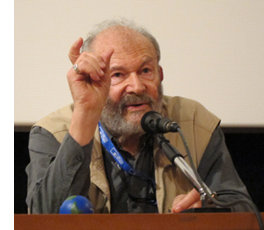 Bachmann, dynamic and articulate at 84, offered many thoughts on the film and how he wound up making it. A cosmopolitan intellectual, he began producing an interview show for WBAI radio, a major initiative in American film culture. His talks with Fellini, Tarkovsky, and others proceed from his conviction that “The person is more important than the film.” By that he means that you never really make the film you have in your head—you get at best 80%–and you end up lying about your mistakes. But the person has an achieved identity. “My life’s work is to meet the people behind the camera.”
Bachmann, dynamic and articulate at 84, offered many thoughts on the film and how he wound up making it. A cosmopolitan intellectual, he began producing an interview show for WBAI radio, a major initiative in American film culture. His talks with Fellini, Tarkovsky, and others proceed from his conviction that “The person is more important than the film.” By that he means that you never really make the film you have in your head—you get at best 80%–and you end up lying about your mistakes. But the person has an achieved identity. “My life’s work is to meet the people behind the camera.”
Over eight hundred hours of those meetings have been preserved in Bachmann’s audio archive, Vox Humana—The Voice Bank. The model for Bachmann has always been not the interview, with its predictable questions and stale answers, but the conversation, “just friends talking.” Bachmann, a straightforward and serious man, was forty when he made Underground New York, and he retains the mature lucidity on display in his comments in that film—and in his film criticism, which I remember reading with pleasure in Film Quarterly in the 1960s. We’re likely to get an earful of his archive, for Criterion has already signed up the North American rights to the Vox Humana collection.
KT here:
Given the great abundance of films at this year’s festival—some might say an overabundance—I singled out out three threads to concentrate on. I resolutely ignored the others unless I could somehow fit a film in here and there. Naturally I chose the second part of the Albert Capellani retrospective that began last year; I wrote about the 2010 season here and will do a follow-up soon. I also chose the 1911 “Cento Anni Fa” programs, since, as usual, the festival presented films from exactly one hundred years ago. Not surprisingly, the most interesting among these were by Feuillade, which David covers above, and Capellani. Finally, since I have a particular interest in Weimar cinema, I stuck with the “Conrad Veidt, From Caligari to Casablanca” retrospective.
The title refers to what are probably Veidt’s two most famous roles, as the somnambulist Cesare in Das Cabinet des Dr. Caligari (1920) and his final performance, as the Nazi Major Strasser, in Casablanca (1942). But presumably on the assumption that just about everyone knows these two films well, Il Cinema Ritrovato didn’t show either one. Instead, the program successfully assembled a group of lesser-known Veidt performances. Despite the fact that I’ve seen a lot of Veidt’s films from the 1910s and 1920s, almost all the items on offer were new to me. The selection seemed designed to display the considerable range of an actor often identified with villainous roles, like his portrayals of Nazis in the 1940s, or downright demonic, like Ivan the Terrible in Waxworks.
Almost none of the films in the program were newly discovered or restored. Most were drawn from existing prints held by various archives. The Wandering Jew, for example, was a beautiful print from the National Film and Television Archive, but it was full of splices, often with whole lines of dialogue missing. The exception was The Thief of Bagdad, a newly restored version shown as one of the evening screenings in the Piazza Maggiore. Not having the stamina that we once had for nearly round-the-clock film viewing, David and I missed all of those. I also passed up the familiar Waxworks (1924, Paul Leni), which I gather was shown in the same dark, indistinct version that has been circulating for years. It’s a film ripe for restoration, but perhaps no better material survives. That would be a pity, since it’s the one film that three of the main Expressionist actors, Veidt, Werner Krauss, and Emil Jannings appeared in together. Leni is also an interesting director, as well as a set designer; perhaps a retrospective of his largely unknown body of work could be arranged someday.
Apart from these, the program pulled together an admirable selection of films. The earliest, Dida Ibsens Geschichte (“Dida Ibsen’s Story,” 1918, Richard Oswald), was a sequel to the original version of Das Tagebuch einer Verlornenen, later remade in 1929 by G. W. Pabst with Louise Brooks. Veidt features relatively little in Dida Ibsen, playing a rich man who takes Dida as his mistress. The film is stolen by Werner Krauss, however, playing a highly eccentric man who forces Dida to marry him and then terrorizes her and their little daughter. Their home is crammed with what appear to be the exotic souvenirs of the husband’s adventures, including Asian furnishings and curios, as well as a parrot, crocodile, and lively python. Krauss carried the latter curled around his body much of the time. Indeed, where else could one see two snake-carrying villains in a single week? Three days later I watched Burl Ives sporting a cottonmouth moccasin in Nicholas Ray’s Wind across the Everglades, a film from the color series that I managed to fit into my schedule.
Veidt’s demonic roles are well represented here not only by Waxworks but also by the 1922 historical epic Lucrezia Borgia (also directed by the prolific Richard Oswald). I had expected the latter to be the usual stodgy historical drama, but it was livelier and more enjoyable than I had expected. Veidt plays the ruthless Cesare Borzia, lusting after his sister Lucrezia and scheming against her repeatedly until he leads a suicidal attack on the fort where her husband is defending her. The fort itself is an immense, lumpy set of the kind common in German epics of the 1920s, That, along with the huge armies of extras, suggests that this was one of the biggest-budget films prior to Metropolis.
Veidt was more versatile than such roles would suggest, however. He often played intense, suffering young men, as in one of F. W. Murnau’s earliest surviving films, Die Gang in der Nacht (1920, not, as in the catalogue, 1922). Veidt plays a supporting role as a mysterious, spiritual young painter who has been blinded. His more cheerful side was in evidence in the wonderful musical The Congress Dances (19331, Eric Charell); there as the confidently scheming Metternich he smilingly relishes eavesdropping on officials and politicians and reading their sealed letters with a contraption involving a bright lamp and magnifying lenses. He plays a Prussian military hero in Die letzte Kompagnie (1930, Kurt—later Curtis—Bernhardt), an early talkie shown in what appeared to be an English-language version, part dubbed, part redone with the actors speaking English.
Veidt’s ability to play both sympathetic and dastardly characters was shown off in the final two offerings, scheduled back to back, in both of which he plays diametrically opposed brothers: Die Brüder Schellenberg (1926, Karl Grune) and Nazi Agent (1942, Jules Dassin). Seeing the two films juxtaposed was odd. In each one, the evil brother is played by Veidt as he usually looked, with dark hair slicked back from his face, while the virtuous brother is gray-haired, reserved, with a little goatee (below). One has to suspect that Dassin saw the earlier film, and in fact Die Brüder Schellenberg was screened at the festival in an American print entitled Two Brothers.
The Mosfilm site offers some Barnet titles for downloading, without subtitles and for a fee. The short list includes A Small Station. The opening twelve minutes, with subtitles, can be found on YouTube. A Good Lad is available here, for free, without subtitles.
For a lovingly compiled fan site, see The Conrad Veidt Society, but beware the Wikipedia entry.
[Thanks to Armin Jäger for correcting my mistake on the date for The Congress Dances.]
Conrad Veidt and Conrad Veidt in Nazi Agent.
Robert Sklar, historian of film and culture
KT, Adrienne Harris, and Robert Sklar. Beijing, 1988.
We have just learned of the death of Professor Robert Sklar after a bicycling accident.
This is a great loss. Bob was a scholar of immense energy and keen intelligence. His books will endure for a very long time, built as they are on careful scholarship and imaginative interpretation. Bob’s background in American Studies made him a pungent cultural historian of cinema long before Cultural Studies became a subfield of film studies. A researcher of old-fashioned virtues, he wrote with a transparency and vivacity that scholars seldom muster. He also didn’t shrink from political criticism, as seen in some of his work for Cineaste, a journal with which he was identified for many years.
Bob was a down-to-earth, good-humored guy. When David taught for a semester at NYU in 1979, Bob was a great boss, warning that one had to know every department’s “folkways.” When we were invited to China to lecture, the genial presence of Bob and Adrienne made it a trip we’ll always remember–not least for Bob’s daily quest to find a Times so he could check on baseball scores. This remarkable man will be much missed.
Matt Singer’s tribute to Robert Sklar is at IFC here.
PS 6 July: See also Frances Guerin’s, Eric Kohn’s, and Jim Hoberman’s tributes to Bob.
PPS 8 July: See Richard Allen’s comprehensive tribute on the SCMS site, and the Variety story as well.
Written on the rewind
The High and the Mighty: The view from the café at the Cineteca of Bologna.
DB here:
Bologna’s Cinema Ritrovato has just ended, and while Kristin and I hustle to write some final entries about films we’ve seen, here are a few images, or maybe lobby cards, from the biggest Ritrovato yet. If we’ve so far posted fewer dispatches than in previous years…that’s largely because the expanded screening list (a fourth venue was added) kept us busy!
If you’re unfamiliar with the Ritrovato, our 2007 orientation is here. For a complete account, check our category Festivals: Cinema Ritrovato. And for many more images from the festival, see the Ritrovato page here, which includes shots of Bertolucci and Charlotte Rampling, as well as a video of a Piazza Maggiore mini-concert.
The Crowd: A full house for Murnau’s Der Gang in die Nacht.
Café Lumière: Pierre Rissient, man of the cinema, and Li Cheuk-to of the Hong Kong International Film Festival.
Le silence est d’or: Silent-film impresarios Jon Gartenberg of Gartenberg Media and Kim Tomadjoglou, curator of the Alice Guy Blaché retrospective.
Summer Storm: Gian Luca Farinelli of the Cineteca and Peter Becker of Criterion take shelter in a portico.
In the Mood for Love: Susan Ohmer and Don Crafton of Notre Dame University.
Make Mine Music: Maud Nelissen and Donald Sosin, virtuoso accompanists for Bologna screenings.
Le Doulos (x 2): Olaf Möller and Christoph Huber of the Ferroni Brigade pioneering a new form of digital cinema.
The History Boys: Naum Kleiman of the Moscow Central Cinema Museum, and Ian Christie of Birkbeck College, University of London.
Gentleman Jim: Jim Healy of the University of Wisconsin–Madison Cinematheque.
Cinema Paradiso: Introduction to one of the nightly screenings on the Piazza Maggiore.












